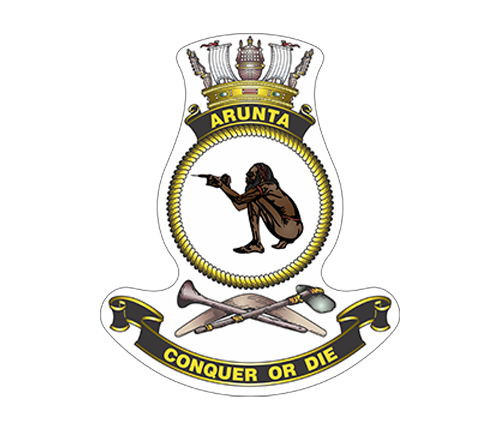Built by Tenix Defence Systems in Williamstown, Victoria, HMAS Arunta (II) is the second of eight Anzac Class frigates based on the German Meko 200 frigate. Anzac Class is a long-range frigate capable of air defence, surface and undersea warfare, surveillance, reconnaissance and interdiction.
Commissioned on 12 December 1998, Arunta is the second ship of the name. The original HMAS Arunta (I), commissioned in 1942, became one of the best-known RAN ships in World War II. She served with distinction in New Guinea and the Pacific from 1942 to 1944, the Battle of Leyte Gulf in 1944, and Lingayen Gulf in 1945.
The Anti-Ship Missile Defence upgrade program significantly improved combat capabilities, providing enhanced sensor and weapons systems capabilities. The upgrade included Phased Array Radar technology designed by CEA Technologies in Canberra, upgrades to combat systems performed by Saab Systems in South Australia, and platform integration design by BAE Systems in Victoria.
The ships are fitted with air and surface surveillance radars, omni-directional hull-mounted sonar, and electronic support systems that interface with the 9LV453 Mk3E combat data system. These systems can counter simultaneous threats from aircraft, surface vessels and submarines.
The ship's main armament comprises one Mark 45 capable of firing 20 rounds per minute, ship launched Mark 46 torpedoes and a Mark 41 vertical launch system for the Evolved Sea Sparrow missile. Anzac also has eight anti-ship/land attack canister launched harpoon missiles. The ship's other defence systems include the Nulka active missile decoy system, offboard chaff and a torpedo countermeasures system.
The frigates feature a ‘combined diesel or gas’ (CODOG) propulsion plant which enables the ship to sustain sprint speeds of greater than 27 knots and allows an operational range in excess of 6000 nautical miles at 18 knots.
The frigates also allow Navy's multi-role MH-60R Seahawk helicopter to launch from the ship, providing enhanced anti-submarine and anti-surface warfare and search and rescue capabilities. Embarkation of a helicopter also provides the ship with the capability to deliver air-launched missiles and torpedoes.
HMAS Arunta was the first Anzac class frigate to complete the Anzac Mid-Life Capability Assurance Program (AMCAP) upgrade at the Australian Marine Complex in Henderson, Western Australia. The AMCAP upgrade involved:
- replacement of Long Range Air search radar
- IFF (identification, friend or foe)
- secondary surveillance radar capabilities
- improvements to platform reliability and maintainability
- habitability for the crew
- improvements to communications systems.
Specifications
| Commanding Officer | Commander David Smith |
|---|---|
| Class | Anzac Class |
| Type | Frigate, Helicopter (FFH) |
| Role |
|
| Pennant | 151 |
| International callsign | VKMQ |
| Motto | Conquer or Die |
| Home port | Fleet Base East |
| Builder | Tenix Defence Systems |
| Launched | 28 June 1996 |
| Commissioned | 12 December 1998 |
| Displacement | 3600 tonnes |
| Length | 118 metres |
| Beam | 14.8 metres |
| Draught | 4.5 metres |
| Speed | 27 knots |
| Range | 6000 nautical miles |
| Crew | 177 |
| Machinery |
|
| Missiles |
|
| Guns |
|
| Torpedoes | 2 x Mk32 Mod 5 triple mounted torpedo tubes |
| Physical countermeasures |
|
| Electronic countermeasures |
|
| Radars |
|
| Sonars |
|
| Combat data systems | Saab Systems 9LV453 Mk3E |
| Electro-optic systems |
|
| Helicopters | 1 x MH-60R Seahawk |

Function
Helicopter frigate